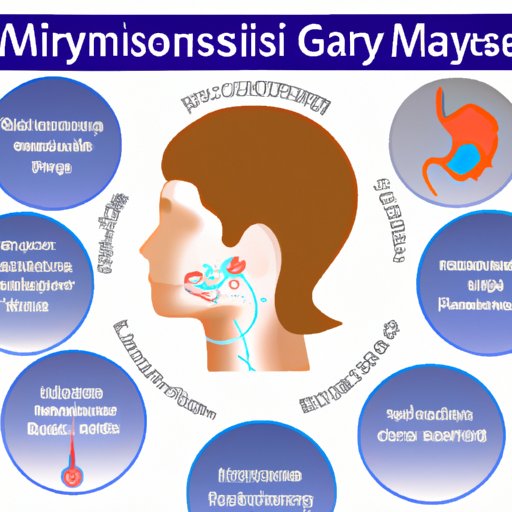
Introduction
Myasthenia Gravis (MG) is a chronic autoimmune neuromuscular disease that causes weakness and fatigue in the muscles responsible for movement and breathing. It affects people of all ages and genders, and while it is a relatively rare disease, it can have a significant impact on an individual’s quality of life. Understanding MG as an autoimmune disease is essential for accurate diagnosis and effective treatment.
In this article, we will provide a comprehensive guide to understanding MG as an autoimmune disease. We will explore the symptoms, diagnosis, and available treatment options for individuals with MG. Additionally, we will discuss the differences between autoimmune and non-autoimmune forms of MG and why it is important to distinguish between the two. We will also address common myths and misconceptions about MG as an autoimmune disease and provide insights from individuals living with the disease.
Comprehensive Guide to Understanding Myasthenia Gravis as an Autoimmune Disease: Symptoms, Diagnosis, and Treatment
Myasthenia Gravis is a chronic autoimmune neuromuscular disease that affects the connection between nerves and muscles. In individuals with MG, their own immune system mistakenly attacks the receptors that receive messages from the nerves and tell the muscles what to do. This results in muscle weakness and fatigue that can affect various muscles throughout the body.
The most common symptoms of MG as an autoimmune disease are muscle weakness and fatigue that worsens with activity and improves with rest. This can manifest in various muscles throughout the body, including those responsible for eye movements, facial expressions, swallowing, and breathing. Other symptoms may include drooping eyelids, double vision, difficulty speaking, trouble chewing, and shortness of breath.
Diagnosing MG as an autoimmune disease can be challenging as its symptoms can be similar to those of other neuromuscular diseases. A thorough medical history, physical examination, and diagnostic tests like blood tests, nerve conduction studies, and electromyography (EMG) can be used to confirm a diagnosis of MG.
There are various available treatment options for individuals with MG as an autoimmune disease, including medications that improve neuromuscular transmission and immunosuppressants that reduce the production of antibodies. In severe cases of MG, plasmapheresis or intravenous immunoglobulin therapy may be necessary. Surgery may also be an option for some individuals.
Myasthenia Gravis: A Comparative Analysis between Autoimmune and Non-autoimmune Forms of MG
Myasthenia Gravis can be categorized as either autoimmune or non-autoimmune, depending on the cause of the disease. Autoimmune MG is the most common form and is caused by the mistaken production of antibodies that attack the receptors on muscle cells. Non-autoimmune MG can be caused by a variety of factors, including medication side effects, tumors, and genetic abnormalities.
While the symptoms of both autoimmune and non-autoimmune forms of MG can be similar, it is important to distinguish between the two in order to develop the best treatment plan. Autoimmune MG is typically treated with immune-modulating therapies that target the specific antibodies causing the disease, whereas non-autoimmune MG may require different treatment options depending on its underlying cause.
Debunking Misconceptions: Common Myths About Myasthenia Gravis as an Autoimmune Disease
There are several common myths and misconceptions about Myasthenia Gravis that can cause confusion and potentially harm individuals with the disease. One of the most common myths is that MG is solely a muscular disease, which is not accurate as it is a neuromuscular disease that affects the connection between nerves and muscles. Another myth is that MG is contagious, which is false as it is not caused by a virus or bacteria.
Dispelling these myths is important as understanding the true nature of MG as an autoimmune disease can help individuals better manage their symptoms and seek appropriate treatment. It can also reduce stigma and improve public awareness about the disease.
Current Research and Advances in Myasthenia Gravis as an Autoimmune Disease: A State of the Art Review
There have been several recent advances in research and treatment options for individuals with Myasthenia Gravis. One promising treatment involves the use of monoclonal antibodies that specifically target the antibodies causing the disease. Other research has focused on developing therapies that can restore the function of the immune system in individuals with MG.
Advances in technology have also made it possible to develop wearable devices that monitor muscle activity and provide real-time feedback to individuals with MG. This can help them better manage their symptoms and prevent exacerbations.
Living with Myasthenia Gravis as an Autoimmune Disease: Personal Accounts and Coping Strategies
Living with Myasthenia Gravis as an autoimmune disease can be challenging, both physically and emotionally. It can be helpful to connect with others who understand the challenges of living with MG and to develop coping strategies that work for each individual.
Personal accounts from individuals living with MG can provide insights and encouragement for others facing similar struggles. Coping strategies vary depending on the individual, but may include physical therapy, regular exercise, stress reduction techniques, and seeking support from family and friends.
Conclusion
Myasthenia Gravis is a chronic autoimmune neuromuscular disease that affects many individuals worldwide. Understanding its nature as an autoimmune disease is essential for accurate diagnosis and effective treatment. In this article, we provided a comprehensive guide to understanding MG as an autoimmune disease, including symptoms, diagnosis, treatment options, and current research. Additionally, we addressed common myths and misconceptions about MG and shared personal accounts from individuals living with the disease. We hope this article provides helpful insights and encourages readers to seek more information and support.




